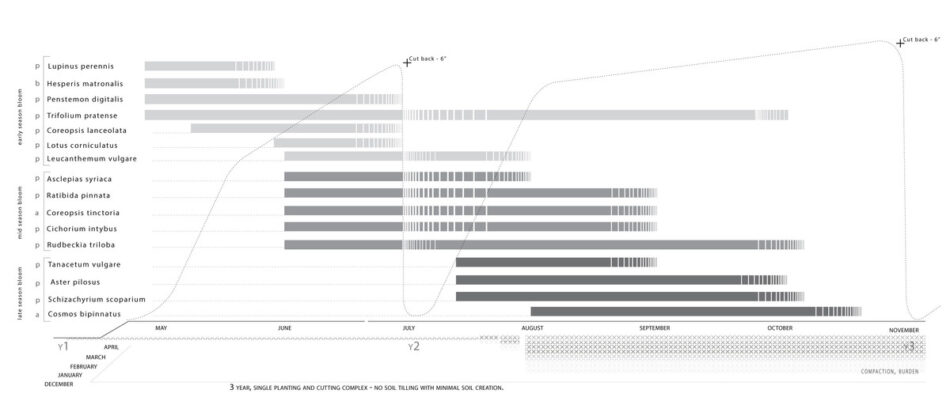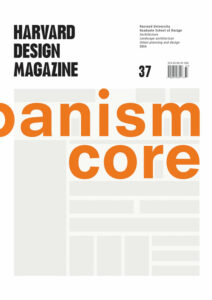A Cosmopolitan Urban Meadow for the Northeast
With over 50 percent of the world’s population now living in cities, the discipline of urban ecology has finally emerged from the shadows to take its proper place in discussions about the future of the environment.
Urban ecosystems are different from “natural” ecosystems in two main ways: they are human-dominated environments characterized by high levels of disturbance, impervious surface, soil compaction, carbon dioxide, and temperature, and their inhabitants (both human and nonhuman) come from all parts of the world—defying the classical dichotomy of native and nonnative. In short, urban ecosystems are novel and cosmopolitan.
The basic idea behind the Cosmopolitan Urban Meadow is to create, from seed, a stable assemblage of stress-tolerant, low-maintenance herbaceous perennial plants that are preadapted to harsh urban conditions and that will provide an attractive vegetation cover on vacant land. Such a “dry meadow” can become a long-term landscape feature in its own right or until a use for the site is worked out at some future time. Regardless of how long it lasts, this short-term solution has the capacity to increase the aesthetic and ecological value of vacant land without the investment of large sums of money typically required for the installation and maintenance of traditional managed landscapes. The cost-effectiveness of the urban meadow typology has particular appeal in light of shrinking municipal budgets that many cities are now experiencing.
The composition of the Cosmopolitan Urban Meadow varies according to specific site conditions and includes native North American as well as European and Asian species. What all the plants have in common is the ability to grow well in sunny, dry habitats and are tolerant of the compactied, alkaline soils that characterize many cities. Such an eclectic mix of species acknowledges not only the long history of immigration and ecological abuse that characterize many urban areas but also the reality of climate change–induced environmental stresses that make the “restoration” of past native ecosystems an ecological (and financial) fantasy.
A. Criteria for Selecting Species
- All plants should be readily available from seed that is commercially available (economic value).
- Most plants should mainly be long-lived perennials, capable of spreading asexually once established (economic and sustainable value).
- The mix should contain a few annual and/or biennial species to provide color during the first year or two after sowing (for popular appeal).
- All plants should be tolerant of full sun, drought, soil compaction, and soil pH of 6 and higher (sustainability and resilience value).
- Most plants should produce showy flowers that attract a wide variety of pollinating insects and seed-eating birds (aesthetic and biodiversity value).
- As a group, the plants should display a range of bloom times from spring through fall (aesthetic and biodiversity value).

B. Site Preparation
- It is important to keep the nutrient levels of the site low to reduce the potential for competition from unwanted species and to prevent the vegetation from growing too vigorously and becoming too tall.
- Minimal investment approach: blacktop or rubble soil, limited budget: (1) remove blacktop and clean up soil surface of any loose debris and rubble; (2) scarify (till) the soil to a depth of about 2 inches.
- Moderate investment approach: blacktop or rubble soil, reasonable budget: (1) remove any loose debris and rubble (or blacktop) from the soil surface; (2) till 2 inches of clean compost into the soil.
- On former landscape sites with reasonable soil the only preparation necessary is to till to a depth of 2 inches before sowing seeds.
C. Seed Sowing
- Seeds should be hand-sown on the prepared soil surface. Prior to sowing, seeds should be thoroughly mixed with a bulking agent (e.g., sand), an annual cover crop and granulated vesicular-arbuscular mycorrhizae (VAM). Following sowing, the entire area should be lightly raked.
- Sowing should be done in either: (1) early fall (preferred), between September 1 and December 1. This will facilitate the germination of species (mainly forbs) that require chilling in order to germinate; or (2) early spring (less desirable), as soon as the soil can be safely worked. This is not so good for seeds with a chilling requirement.
D. Management
- Midway through the first growing season (when the cover crop is knee high), the meadow should be mowed to a height of about 8 inches to prevent the cover crop (and weeds) from shading out the slower growing wildflower seedlings.
- The meadow should be mowed again at the end of the second season of growth to a height of 4 to 6 inches.
- On sites with poor soil and limited plant growth, mowing once a year—any time after November 1—should be all the maintenance that is required.
- On sites with better soil and more vigorous plant growth, the meadow should be mowed twice a year—once between late-June and early-July and again after November 1. The timing of the first cutting should be early enough in the season to allow summer and fall blooming plants to recover from mowing and produce their flowers. The second cutting will improve not only the appearance of the site in winter but also the growing conditions for the following spring.
- On some sites, depending on their history, undesirable aggressive species such as mugwort, ragweed, or Phragmites may invade the meadow and require some form of control—either hand-pulling or chemical—in order to prevent them from becoming dominant. Annual mowing is sufficient to keep undesireable woody plants in check.
